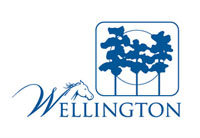On Monday, March 26, Wellington’s Equestrian Preserve Committee held an open forum at the Wellington Community Center as an attempt to provide Wellington residents the opportunity to voice opinions about the overall equestrian impact on the village.
With the end of the current equestrian season in sight, the Equestrian Preserve Committee wanted to, for the first time, create an open space where equestrian and non-equestrian property owners could engage in conversation with each other, as well as express any concerns or thoughts to the committee.
“We are looking for a way to involve all of you across the different preserve neighborhoods, [in order for you to] have a way to talk to us, and for us to have a way to represent your interests year-round,” Committee Chair Jane Cleveland explained.
The forum of roughly 60 people centered on some of the equestrian community’s perennial topics of discussion, such as its economic influence, horse sports, land use, community impact and environmental issues.
Cleveland detailed the ongoing study measuring the economic impact of the equestrian industry on Wellington. She noted that the economic impact from the equestrian industry has been measured in Palm Beach County as a whole, but that the committee is looking to measure strictly Wellington’s economic impact.
The results of the study, which are expected to be released in the next couple of weeks, will demonstrate what the equestrian industry does for Wellington, mainly in discussing jobs, businesses, taxes and real estate value.
A large portion of audience members expressed their satisfaction with Wellington’s place in the equestrian world. The village’s growth and prosperity from horse sports and equestrian venues was repeatedly signaled out as a positive and important attribute to the Wellington community throughout the forum.
Marc Ganzi, owner of the Grand Champions Polo Club and patron of the Audi Polo Team, addressed the committee and the audience to express assurance that polo is not leaving Wellington anytime soon.
He stressed that, last year, polo was played throughout eight of the 12 months of the year, adding that the notion in some quarters claiming polo to be headed for a downturn in Wellington are incorrect.
“What I’m here to tell you, as someone who has been in this community for 17 years, is that polo is in a better place today than it was when I got here,” Ganzi said. “It is more accessible — it’s accessible to women, children and all levels. There is no better place than Wellington, Florida, to show that polo is open to everyone at every skill and level.”
Others felt that Wellington, though it is excelling in equestrian venues, sports and amenities, could expand and improve some of the current resources available for equestrians and their horses.
Mary Ann Simonds said that she chose Wellington after living and working in several other equestrian locations. She expressed a great necessity for more horse trails in Wellington.
“Across the country, the number one thing that preserves horse communities is horse and bridle trails. As long as there are trails, that cannot be removed or paved over, there will always be a horse community,” Simonds said. “We have a great opportunity to attract the people we want.”
Although a majority of people at the forum expressed acceptance and appreciation of the strong equestrian presence and influence on Wellington’s community, some also felt reluctant about planned future equestrian expansion. Some said that they feel comfortable with the established balance between the current equestrian parts of the village and the non-equestrian parts of the village, but are fearful of what more equestrian development could mean for the community as a whole.
Equestrian Club resident Mark Albers brought up issues he foresees when discussing further development. As the Equestrian Club is adjacent to the International Polo Club Palm Beach, Albers explained that noise is a constant constraint in his neighborhood and that further development at IPC would affect his neighborhood even more.
“On the weekends, [we] can hear horses and trailers from 8 a.m. through dusk. We are used to [the noise], but new development, new venues and more sporting events — along with the [increased] whistles, megaphones, announcements and car noise — do impact us,” Albers said.
William McCue, an Eastwood resident, raised the question of the equestrian area’s impact on the rest of Wellington. McCue explained that he appreciates equestrians, but also expressed that the opinions of non-equestrians are not being considered when making decisions to expand or further develop the equestrian community.
“I would say that the great majority of Wellington residents are happy with what is happening in the equestrian community, but we also have to address the non-equestrians’ concerns,” he said. “There are as many as 20,000 horses [in Wellington] in season, so, if you want to expand things, then my question is how much more do you want to expand?”
Along with the effects from equestrian communities on those communities bordering the Equestrian Preserve Area, McCue also expressed concerns about the environmental impact from the growing equestrian industry.
“One of the major things that affects me and my family, and everybody’s family here, is what we are doing with the manure from 20,000 horses,” McCue said. “A 1,000-pound horse produces around nine tons of manure per year. We have heard stories that the haulers taking [the manure] are not disposing of it properly. As a community, we all need to address that before it becomes more of a problem.”








